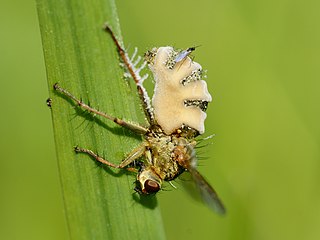
Ascomycota is a phylum of the kingdom Fungi that, together with the Basidiomycota, forms the subkingdom Dikarya. Its members are commonly known as the sac fungi or ascomycetes. It is the largest phylum of Fungi, with over 64,000 species. The defining feature of this fungal group is the "ascus", a microscopic sexual structure in which nonmotile spores, called ascospores, are formed. However, some species of Ascomycota are asexual and thus do not form asci or ascospores. Familiar examples of sac fungi include morels, truffles, brewers' and bakers' yeast, dead man's fingers, and cup fungi. The fungal symbionts in the majority of lichens such as Cladonia belong to the Ascomycota.

Zygomycota, or zygote fungi, is a former division or phylum of the kingdom Fungi. The members are now part of two phyla: the Mucoromycota and Zoopagomycota. Approximately 1060 species are known. They are mostly terrestrial in habitat, living in soil or on decaying plant or animal material. Some are parasites of plants, insects, and small animals, while others form symbiotic relationships with plants. Zygomycete hyphae may be coenocytic, forming septa only where gametes are formed or to wall off dead hyphae. Zygomycota is no longer recognised as it was not believed to be truly monophyletic.

The Mucorales is the largest and best-studied order of zygomycete fungi. Members of this order are sometimes called pin molds. The term mucormycosis is now preferred for infections caused by molds belonging to the order Mucorales.

The Entomophthorales are an order of fungi that were previously classified in the class Zygomycetes. A new subdivision, Entomophthoromycotina, in 2007, was circumscribed for them.
Sporogenesis is the production of spores in biology. The term is also used to refer to the process of reproduction via spores. Reproductive spores were found to be formed in eukaryotic organisms, such as plants, algae and fungi, during their normal reproductive life cycle. Dormant spores are formed, for example by certain fungi and algae, primarily in response to unfavorable growing conditions. Most eukaryotic spores are haploid and form through cell division, though some types are diploids or dikaryons and form through cell fusion. This type of reproduction can also be called single pollination.

Entomophthora is a fungal genus in the family Entomophthoraceae. Species in this genus are parasitic on flies and other two-winged insects. The genus was circumscribed by German physician Johann Baptist Georg Wolfgang Fresenius (1808–1866) in 1856.

Phycomycetes is an obsolete polyphyletic taxon for certain fungi with aseptate hyphae. It is used in the Engler system. Asexual reproduction takes place by zoospores (motile) or by Aplanospores (non-motile). These spores are endogenously produced in sporangium. A zygospore is formed by fusion of two gametes. These gametes are similar in morphology (isogamous) or dissimilar.

Conidiobolus is a genus of fungi in order Entomophthorales. Some species were defined in Conidiobolus but then moved into other genera such as Capillidium and Batkoa.

Mucoromycotina is a subphylum of uncertain placement in Fungi. It was considered part of the phylum Zygomycota, but recent phylogenetic studies have shown that it was polyphyletic and thus split into several groups, it is now thought to be a paraphyletic grouping. Mucoromycotina is currently composed of 3 orders, 61 genera, and 325 species. Some common characteristics seen throughout the species include: development of coenocytic mycelium, saprotrophic lifestyles, and filamentous.

The Mortierellaceae are a family of fungi in the order Mortierellales. The family contains six genera and 93 species.
Mycetophagites is an extinct fungal genus of mycoparasitic in the order Hypocreales. A monotypic genus, it contains the single species Mycetophagites atrebora.

Entomophthoromycota is a division of kingdom fungi. In 2007, it was placed at the taxonomic rank of subphylum in the most recent revision of the entire fungus kingdom. In 2012, it was raised to the rank of phylum as "Entomophthoromycota" in a scientific paper by Richard A. Humber 2012. Divided into three classes and six families, it contains over 250 species that are mostly arthropod pathogens or soil- and litter-borne saprobes.

Zoophagus is a genus of zygomycete fungi that preys on rotifers and nematodes. It was established in 1911 by Sommerstorff, who originally considered it to be an oomycete. It is common in a variety of freshwater habitats, such as ponds and sewage treatment plants.
Zoophthora is a genus of fungi in the family Entomophthoraceae. Like other taxa in this family, Zoophthora species cause disease in insects and as such are considered entomopathogenic fungi.

Amoebophilus is a genus of zygomycete fungi that parasitizes amoeba.

Trisporic acids (TSAs) are C-18 terpenoid compounds synthesized via β-carotene and retinol pathways in the zygomycetes. They are pheromone compound responsible for sexual differentiation in those fungal species. TSAs and related compounds make up the trisporoid group of chemicals.
Stylopage is a polytypic genus of predacious fungus in the order Zoopagales, within the subphylum Zoopagomycotina. All known species of Stylopage subsist on various species of amoebae or nematodes by trapping their prey, typically using an adhesive substance that coats their vegetative hyphae, and absorbing nutrients through the projection of a haustorium. 17 extant Stylopage species have been described thus far.
Batkoa is a genus of fungi within the family of Entomophthoraceae and order Entomophthorales of the Zygomycota. This has been supported by molecular phylogenetic analysis.
Meristacrum is a fungal genus in the monotypic family Meristacraceae, of the order Entomophthorales. They are parasites of soil invertebrates, they typically infect nematodes, and tardigrades.
Basidiobolus haptosporus belongs to the Kingdom Fungi and is a member of a grouping known as the "zygomycetes". This classification comprises two Phyla- the Mucoromycota and the Zoopagomycota, which are characterized by the production of sexual zygospores and suspensor cells. B. haptosporus is a filamentous fungus with distribution concentrated in Tropical and Subtropical regions. This fungus is largely associated with the gastrointestinal tract of amphibians and reptiles but has also been reported on mite bristles. B. haptosporus has caused disease in humans as well, including Gastrointestinal entomophthoromycosis and subcutaneous phycomycosis. Closely related species include Basidiobolus ranarum, B. meristosporus, B. microsporus, and B. magnus.











